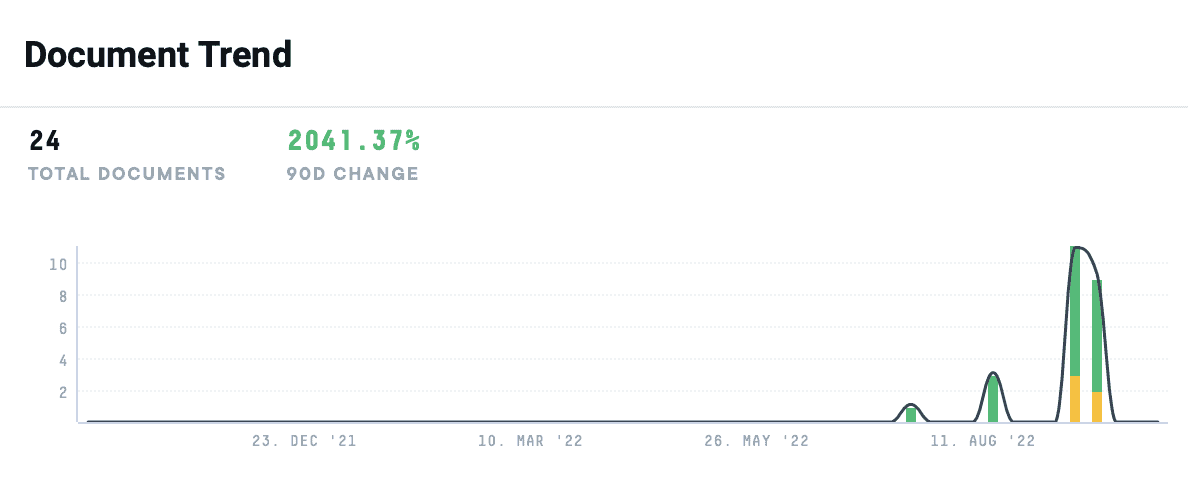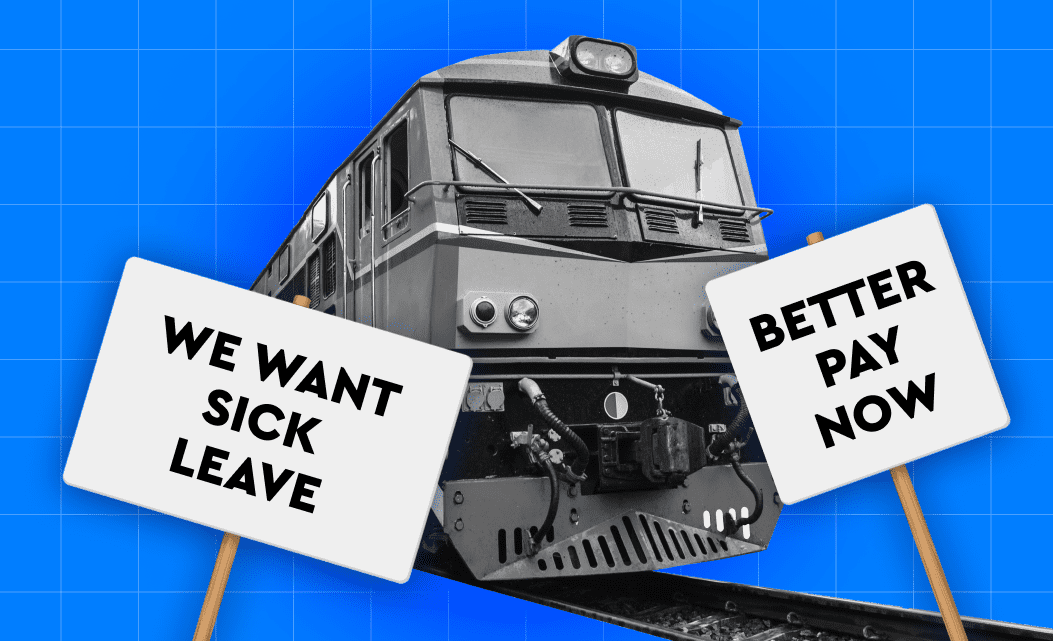This past September, railroad workers across the nation announced an ensuing strike that would have cost the US economy roughly $2 billion a day–a financial blow that would have forced many businesses to scale back or cease production and consider layoffs–if their working conditions issues were not addressed.
While the threat of a strike has been temporarily delayed due to Biden’s recent deal conversations with freight union leaders, there is the possibility that these railroad workers could reject the plans the President has proposed. Regardless of what is proposed or ultimately agreed upon, it is clear that this issue remains a concern to a variety of industries, from agriculture to auto. In the AlphaSense platform, documentation around the rail strike and rail union is up 2038.3%.

Below, we dive into the details of this rising matter and how it could affect the profitability of three key industries: Chemical, Energy, and Agriculture.
The Railroad Strike and (Temporary) Resolution
Railroad union workers have brought issues to their trying work conditions: expanding workloads and strict attendance policies resulting from major railroad companies cutting about a third of jobs (45,000) from their workforce over the last six years.
Across the rail industry, owners have leveraged their job cuts to translate into fewer, longer trains operating with fewer employees, who are on call 24-7. More damning, workers could not take unpaid days off for doctor’s appointments or even be hospitalized without being penalized. It’s these inequities that have led shippers to report growing delays and poor service–also, a direct result of railroads struggling to hire quickly enough to meet surging demands that resulted from the pandemic.
Growing frustrations and the resulting plans for a strike, all happening two months before the midterm elections, led to President Joe Bidden’s involvement in the matter. Meetings between the Labor Department and railroad unions that represent 115,000 workers from various companies, including Union Pacific, BNSF, CSX , Norfolk Southern and Kansas City Southern, led to a 20-hour negotiating session that resulted in amendments to improve working condition
The five-year deal includes a 14.1% pay increase and loosened attendance policies to address the issues raised. While Biden has temporarily prevented a blowout that would cause inflation to soar and cause controversy in his presidency, the deal still needs to be presented and approved by union members.
Titans Still Unhappy and Here is What They are Saying
Both rail owners and workers are unsatisfied with the results of Biden’s deal. Some talks over attendance, sick time and scheduling issues have stalled regarding the new contracts freight railways are proposing to unions. Only two of 12 unions– representing less than 10% of the workforce–have ratified them. Workers have agreed not to strike while votes are tallied over the next several weeks, but this promise may waver if negotiations are drawn out.
Collectively, the 12 railroad unions, including two large groups composed of around 60,000 workers, representing the latest National Freight Rail Bargaining will vote to ratify or reject them over the next several weeks–a potentially challenging objective, experts warned. Union leaders will need to persuade and be able to sell agreements to members. Already, a smaller union composed of the cohort has rejected Biden’s proposal.
These negotiations, however, have been ongoing for more than two years, with Biden only stepping in this past July to assemble an emergency board to handle the issue. And if his plan does not appeal to freight workers and owners, congressional leaders have threatened to pass legislation that would serve as a resolution to that matter.
Three Major Industries Affected by a Potential Rail Strike
While Biden’s deal speaks directly to railroad unions and freightway owners, the discourse between the two and any consequential results could topple economies around the world in a matter of days. Had a rail shutdown occurred without intervention by Biden, a strike could have unleashed a cascade of transport woes affecting US chemical, energy, and agriculture companies.
Chemical
Already, chemical manufacturers within the US have faced challenges in regards to a potential strike. Many had to alert customers about certain shipping restrictions implemented by Class 1 railroads, any carrier earning annual revenue greater than $250 million, ahead of a possible strike.
To put the chemical industry’s reliance on rails in perspective, freight railroads moved 2.2m carloads of plastics, fertilizers and agricultural chemicals in 2021 alone. In the US, chemical railcar loadings represent about 20% of chemical transportation by tonnage, with trucks, barges and pipelines carrying the rest. And in Canada, some producers solely rely on rail to ship over 70% of their products. Recent earnings call transcripts show signs of concern from various chemical companies such as Dow Inc., LyondellBasell Industries, and Eastman Chemical Company. Most notably, Eastman Chemical Company expressed explicit concern for economic implications due to the strike:
“Definitely concerned about just as you think about the broader U.S. economy and the implications that are rail strike, I call it, beyond the historical a few hours to something that could be a few days or longer, I think we should all be worried about something like that,” William Thomas McLain, CFO & Senior VP of Eastman Chemical Company, said in an earnings transcript. “And we’re advocating obviously as others in the industry that there’s a resolution, I think, that’s important for the U.S. and the U.S. economy. We have things in our staging, as you would expect us to do. We have plans from an enterprise standpoint and are activating some of those plans proactively.”
Energy
The effects of a strike on the energy industry are far-reaching, with some experts believing the consequences would directly hurt consumers in the gasoline, electricity and natural gas prices they pay. In addition, refineries would potentially have to halt production if they are unable to receive essential deliveries and are unable to use railways to ship gasoline. Moreso, there’s an immense danger that could come with leaving flammable chemicals like gasoline abandoned on railroad tracks, which is why railroads have begun reducing shipments of hazardous materials.
According to broker research sourced within the AlphaSense platform, some private equity firms have conversed with companies across the industry to get a consensus on the potential threat of strike coming to fruition. Not only do many believe that the risk is low, but if a strike were to occur, it would be short-lived due to Congress’ ability to step in and prevent or obstruct a labor strike by enforcing the President Emergency Board’s recent contract proposals.
Beyond broker research, earnings calls are another content area showing concern in the platform:
“Forward-looking statements are subject to a number of known and unknown risks, uncertainties and other factors, many of which may be beyond our control, and may cause actual results, performance or achievements to differ materially from those projected in, expressed or implied by forward-looking statements. These risks and uncertainties include, but are not limited to, the following: The possibility of a railroad strike which would cause significant disruption to our ability to receive feedstock and ship our products.” – Quarterly Report from Granite Falls Energy LLC
Agriculture
The agriculture industry, specifically meat and poultry producers, would suffer the backlash of a railroad strike almost immediately, as livestock producers would face shipments of feed abruptly ending. To put the consequences of a strike into context, the nation’s chicken industry receives about 27 million bushels of corn and 11 million bushels of soybean meal to feed chickens weekly.
Lamb Western Holdings, America’s premier potato company, believes that there is still a potential threat to their business that’s worth their attention, even if the rail crisis seems to have been placated. “While a broad rail strike has likely been averted, we continue to closely monitor the status of discussions with the West Coast Stock Workers Union and the impact of potential work slowdown or stoppage may have on our exports,” says Bernadette M. Madarieta, Senior VP & CFO of Lamb Western Holdings.
Key Takeaways
- Biden’s recent deal to appease both railroad unions and owners has not satisfied the demands workers have raised, and analysts are unsure if railroad union leaders will be able to convince their members of the conditions the President has laid out
- A railroad strike would cost the US economy roughly $2 billion every day, and countless industries would be affected, with agriculture, auto, and energy taking the brunt
- Some analysts believe that there is a low possibility of a strike occurring; however, the consequences would be astronomical: many businesses would have to halt or cease production due to the lack of access to the railroads and potentially shudder employees and close their businesses
- Potential railroad strike could have adverse implications for the already-strained packaged food supply chain and commodity prices.
In these trying times, it’s best to keep you and your business ready for the unexpected. In our guide, Four Ways to Approach Global Market Impacting Events, learn how you cannot only survive but thrive in a volatile global market by extracting valuable insights to gain a competitive edge within your sector.
.png)







